technical specifications Seat Ibiza 5D 2010 User Guide
[x] Cancel search | Manufacturer: SEAT, Model Year: 2010, Model line: Ibiza 5D, Model: Seat Ibiza 5D 2010Pages: 266, PDF Size: 7.04 MB
Page 25 of 266
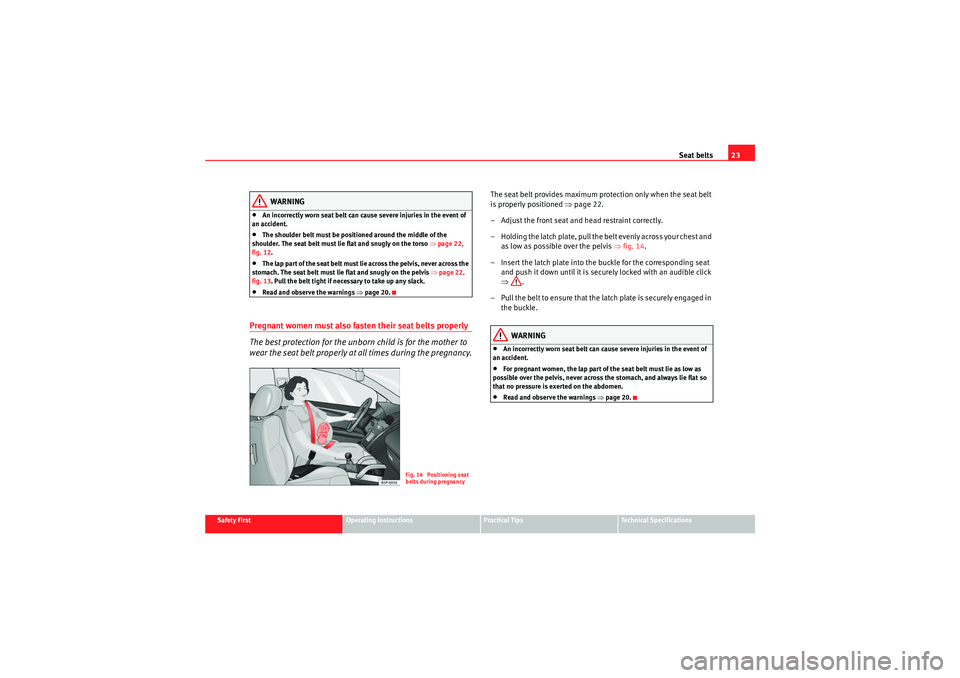
Seat belts23
Safety First
Operating Instructions
Practical Tips
Technical Specifications
WARNING
•An incorrectly worn seat belt can cause severe injuries in the event of
an accident.•The shoulder belt must be positioned around the middle of the
shoulder. The seat belt must lie flat and snugly on the torso ⇒page 22,
fig. 12 .•The lap part of the seat belt must lie across the pelvis, never across the
stomach. The seat belt must lie flat and snugly on the pelvis ⇒page 22,
fig. 13 . Pull the belt tight if necessary to take up any slack.•Read and observe the warnings ⇒page 20.
Pregnant women must also fasten their seat belts properly
The best protection for the unbo rn child is for the mother to
wear the seat belt properly at all times during the pregnancy.
The seat belt provides maximum protection only when the seat belt
is properly positioned ⇒page 22.
– Adjust the front seat and head restraint correctly.
– Holding the latch plate, pull the belt evenly across your chest and as low as possible over the pelvis ⇒fig. 14 .
– Insert the latch plate into the buckle for the corresponding seat and push it down until it is securely locked with an audible click
⇒ .
– Pull the belt to ensure that the latch plate is securely engaged in the buckle.
WARNING
•An incorrectly worn seat belt can cause severe injuries in the event of
an accident.•For pregnant women, the lap part of the seat belt must lie as low as
possible over the pelvis, never across the stomach, and always lie flat so
that no pressure is exerted on the abdomen.•Read and observe the warnings ⇒page 20.
Fig. 14 Positioning seat
belts during pregnancy
Ibiza_EN.book Seite 23 Mittwoch, 1. September 2010 5:24 17
Page 27 of 266
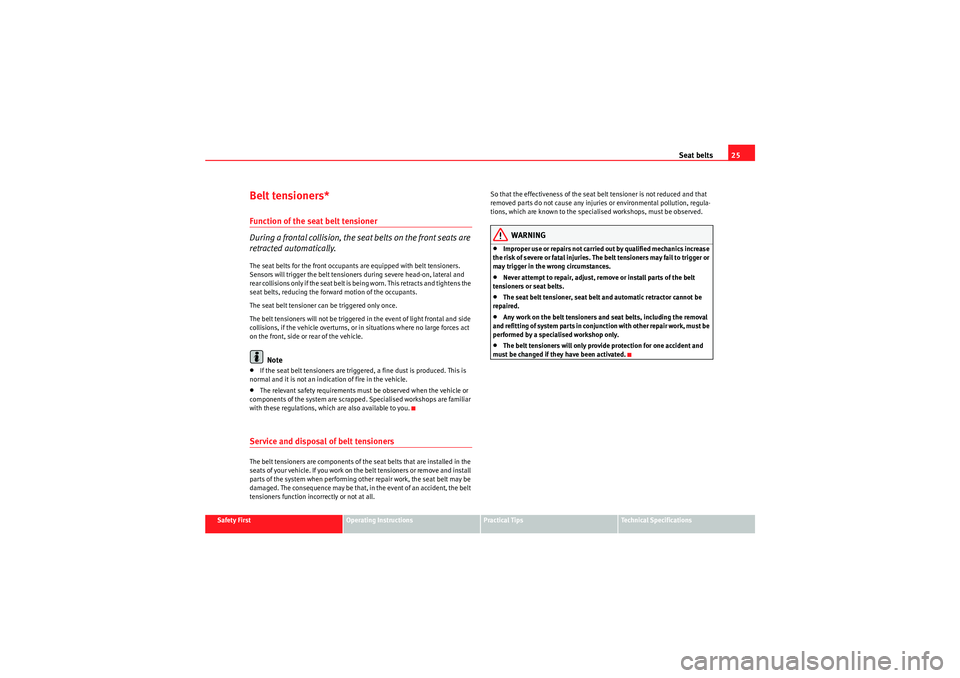
Seat belts25
Safety First
Operating Instructions
Practical Tips
Technical Specifications
Belt tensioners*Function of the seat belt tensioner
During a frontal collision, the seat belts on the front seats are
retracted automatically.The seat belts for the front occupants are equipped with belt tensioners.
Sensors will trigger the belt tensioners during severe head-on, lateral and
rear collisions only if the seat belt is being worn. This retracts and tightens the
seat belts, reducing the forward motion of the occupants.
The seat belt tensioner can be triggered only once.
The belt tensioners will not be triggered in the event of light frontal and side
collisions, if the vehicle overturns, or in situations where no large forces act
on the front, side or rear of the vehicle.
Note
•If the seat belt tensioners are triggered, a fine dust is produced. This is
normal and it is not an indication of fire in the vehicle.•The relevant safety requirements must be observed when the vehicle or
components of the system are scrapped. Specialised workshops are familiar
with these regulations, which are also available to you.Service and disposal of belt tensionersThe belt tensioners are components of the seat belts that are installed in the
seats of your vehicle. If you work on the belt tensioners or remove and install
parts of the system when performing other repair work, the seat belt may be
damaged. The consequence may be that, in the event of an accident, the belt
tensioners function incorrectly or not at all. So that the effectiveness of the seat belt tensioner is not reduced and that
removed parts do not cause any injuries or environmental pollution, regula-
tions, which are known to the specialised workshops, must be observed.
WARNING
•Improper use or repairs not carried out by qualified mechanics increase
the risk of severe or fatal injuries. The belt tensioners may fail to trigger or
may trigger in the wrong circumstances.•Never attempt to repair, adjust, remove or install parts of the belt
tensioners or seat belts.•The seat belt tensioner, seat belt and automatic retractor cannot be
repaired.•Any work on the belt tensioners and seat belts, including the removal
and refitting of system parts in conjunction with other repair work, must be
performed by a specialised workshop only.•The belt tensioners will only provide protection for one accident and
must be changed if they have been activated.
Ibiza_EN.book Seite 25 Mittwoch, 1. September 2010 5:24 17
Page 29 of 266
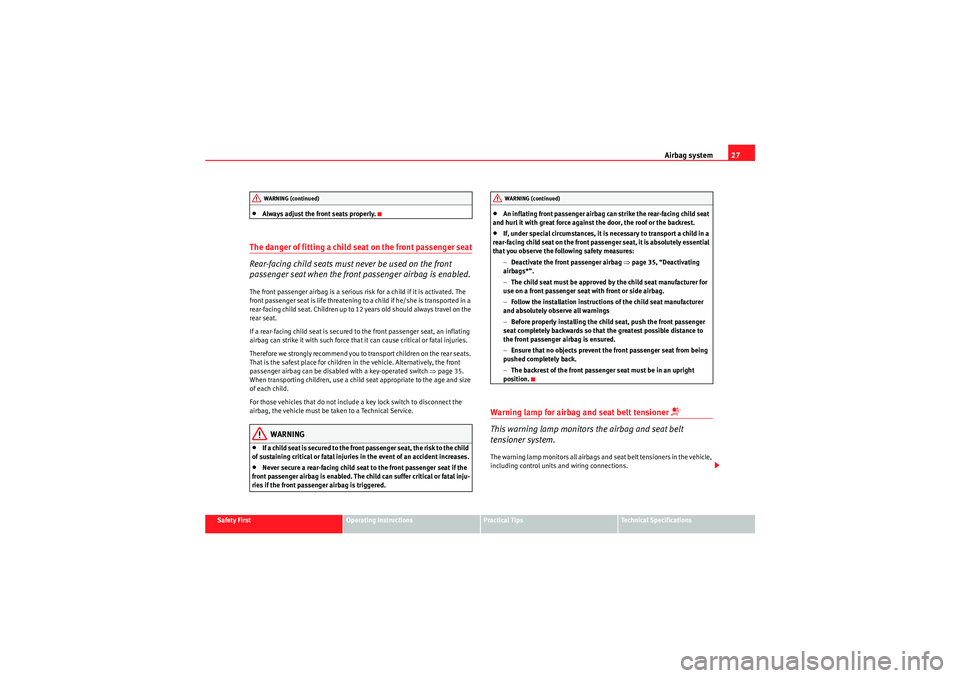
Airbag system27
Safety First
Operating Instructions
Practical Tips
Technical Specifications
•Always adjust the front seats properly.
The danger of fitting a child seat on the front passenger seat
Rear-facing child seats must never be used on the front
passenger seat when the front passenger airbag is enabled.The front passenger airbag is a serious risk for a child if it is activated. The
front passenger seat is life threatening to a child if he/she is transpor ted in a
rear-facing child seat. Children up to 12 years old should always travel on the
rear seat.
If a rear-facing child seat is secured to the front passenger seat, an inflating
airbag can strike it with such force that it can cause critical or fatal injuries.
Therefore we strongly recommend you to transport children on the rear seats.
That is the safest place for children in the vehicle. Alternatively, the front
passenger airbag can be disabled with a key-operated switch ⇒page 35.
When transporting children, use a child seat appropriate to the age and size
of each child.
For those vehicles that do not include a key lock switch to disconnect the
airbag, the vehicle must be taken to a Technical Service.
WARNING
•If a child seat is secured to the front passenger seat, the risk to the child
of sustaining critical or fatal injuries in the event of an accident increases.•Never secure a rear-facing child seat to the front passenger seat if the
front passenger airbag is enabled. The child can suffer critical or fatal inju-
ries if the front passenger airbag is triggered.
•An inflating front passenger airbag can strike the rear-facing child seat
and hurl it with great force against the door, the roof or the backrest.•If, under special circumstances, it is necessary to transport a child in a
rear-facing child seat on the front passenger seat, it is absolutely essential
that you observe the following safety measures:
−Deactivate the front passenger airbag ⇒page 35, “Deactivating
airbags*”.
− The child seat must be approved by the child seat manufacturer for
use on a front passenger seat with front or side airbag.
− Follow the installation instructions of the child seat manufacturer
and absolutely observe all warnings
− Before properly installing the child seat, push the front passenger
seat completely backwards so that the greatest possible distance to
the front passenger airbag is ensured.
− Ensure that no objects prevent the front passenger seat from being
pushed completely back.
− The backrest of the front passenger seat must be in an upright
position.
Warning lamp for airbag and seat belt tensioner
�T
This warning lamp monitors the airbag and seat belt
tensioner system.The warning lamp monitors all airbags and seat belt tensioners in the vehicle,
including control units and wiring connections.
WARNING (continued)
WARNING (continued)
Ibiza_EN.book Seite 27 Mittwoch, 1. September 2010 5:24 17
Page 31 of 266
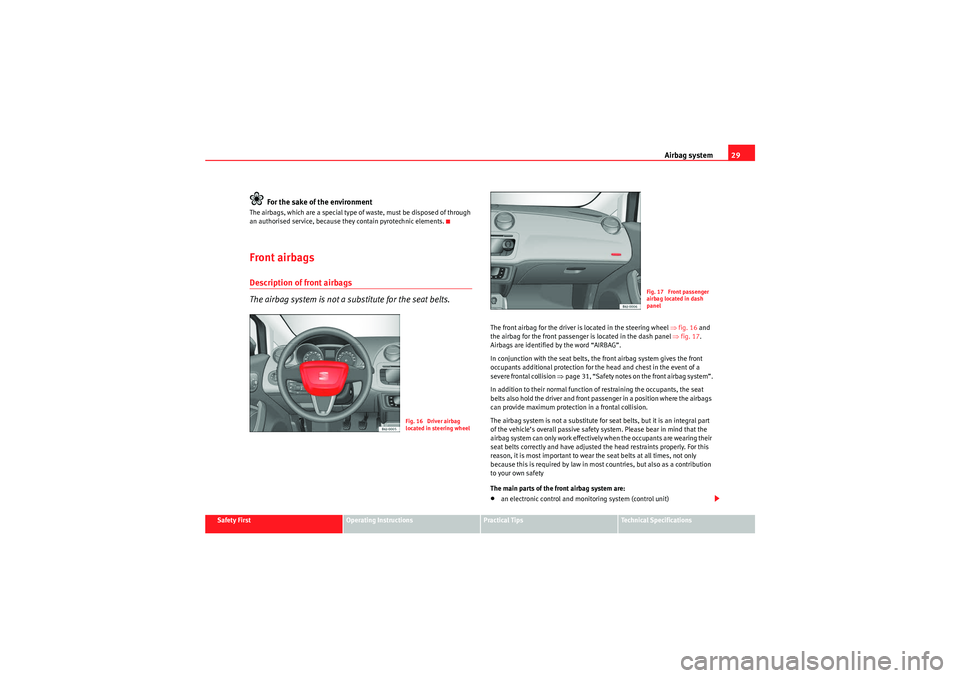
Airbag system29
Safety First
Operating Instructions
Practical Tips
Technical Specifications
For the sake of the environment
The airbags, which are a special type of waste, must be disposed of through
an authorised service, because they contain pyrotechnic elements.Front airbagsDescription of front airbags
The airbag system is not a substitute for the seat belts.
The front airbag for the driver is located in the steering wheel ⇒fig. 16 and
the airbag for the front passenger is located in the dash panel ⇒fig. 17 .
Airbags are identified by the word “AIRBAG”.
In conjunction with the seat belts, the front airbag system gives the front
occupants additional protection for the head and chest in the event of a
severe frontal collision ⇒ page 31, “Safety notes on the front airbag system”.
In addition to their normal function of restraining the occupants, the seat
belts also hold the driver and front passenger in a position where the airbags
can provide maximum protection in a frontal collision.
The airbag system is not a substitute for seat belts, but it is an integral part
of the vehicle’s overall passive safety system. Please bear in mind that the
airbag system can only work effectively when the occupants are wearing their
seat belts correctly and have adjusted the head restraints properly. For this
reason, it is most important to wear the seat belts at all times, not only
because this is required by law in most countries, but also as a contribution
to your own safety
The main parts of the front airbag system are:•an electronic control and monitoring system (control unit)
Fig. 16 Driver airbag
located in steering wheel
Fig. 17 Front passenger
airbag located in dash
panel
Ibiza_EN.book Seite 29 Mittwoch, 1. September 2010 5:24 17
Page 33 of 266

Airbag system31
Safety First
Operating Instructions
Practical Tips
Technical Specifications
develop when the airbag deploys. This is normal and it is not an indication of
fire in the vehicle.
Safety notes on the front airbag system
If you use airbags correctly, they can considerably reduce the
risk of injury in many kinds of accident.
WARNING
•It is important for the driver and front passenger to keep a distance of
at least 25 cm from the steering wh eel or dash panel. If the minimum
distance is not observed, the airbags do not correctly protect the vehicle
occupants; risk of fatal injuries! In addition, the front seats and head
restraints must always be positioned correctly for the height of the occu-
pant.•If you are not wearing a seat belt, if you lean forward or to the side while
travelling or assume an incorrect sitting position, there is a substantially
increased risk of injury. This increased risk of injury will be further
increased if you are struck by an inflating airbag.•Never let a child travel on the front seat without an appropriate restraint
system. If the airbag is triggered in an accident, children can sustain
serious or fatal injuries from the airbag as it inflates ⇒page 37, “Child
safety”.•The deployment space between the front passengers and the airbags
must not in any case be occupied by other passenger, pets and objects.•The airbags provide protection for just one accident; replace them once
they have deployed.•It is also important not to attach any objects such as cup holders or
telephone mountings to the surfaces covering the airbag units.•Do not attempt to modify components of the airbag system in any
way.
Ibiza_EN.book Seite 31 Mittwoch, 1. September 2010 5:24 17
Page 35 of 266
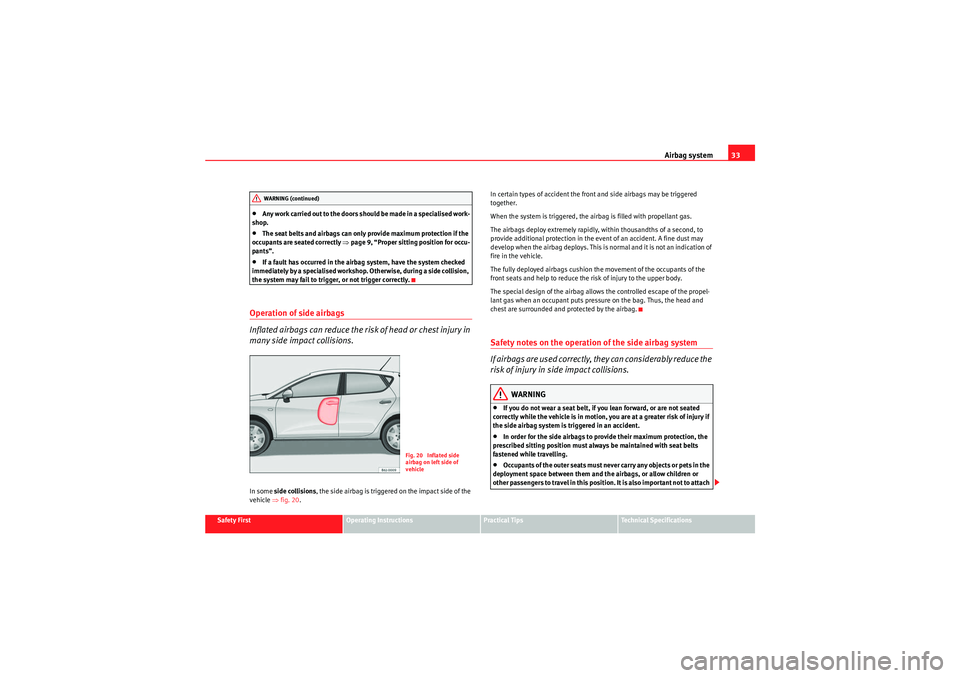
Airbag system33
Safety First
Operating Instructions
Practical Tips
Technical Specifications
•Any work carried out to the doors should be made in a specialised work-
shop.•The seat belts and airbags can only provide maximum protection if the
occupants are seated correctly ⇒ page 9, “Proper sitting position for occu-
pants”.•If a fault has occurred in the airbag system, have the system checked
immediately by a specialised workshop. Otherwise, during a side collision,
the system may fail to trigger, or not trigger correctly.
Operation of side airbags
Inflated airbags can reduce the risk of head or chest injury in
many side impact collisions.In some side collisions , the side airbag is triggered on the impact side of the
vehicle ⇒fig. 20 . In certain types of accident the front and side airbags may be triggered
together.
When the system is triggered, the airbag is filled with propellant gas.
The airbags deploy extremely rapidly, within thousandths of a second, to
provide additional protection in the event of an accident. A fine dust may
develop when the airbag deploys. This is normal and it is not an indication of
fire in the vehicle.
The fully deployed airbags cushion the movement of the occupants of the
front seats and help to reduce the risk of injury to the upper body.
The special design of the airbag allows the controlled escape of the propel-
lant gas when an occupant puts pressure on the bag. Thus, the head and
chest are surrounded and protected by the airbag.
Safety notes on the operation of the side airbag system
If airbags are used correctly, they can considerably reduce the
risk of injury in side impact collisions.
WARNING
•If you do not wear a seat belt, if you lean forward, or are not seated
correctly while the vehicle is in motion, you are at a greater risk of injury if
the side airbag system is triggered in an accident.•In order for the side airbags to provide their maximum protection, the
prescribed sitting position must always be maintained with seat belts
fastened while travelling.•Occupants of the outer seats must never carry any objects or pets in the
deployment space between them and the airbags, or allow children or
other passengers to travel in this position. It is also important not to attach
WARNING (continued)
Fig. 20 Inflated side
airbag on left side of
vehicle
Ibiza_EN.book Seite 33 Mittwoch, 1. September 2010 5:24 17
Page 37 of 266

Airbag system35
Safety First
Operating Instructions
Practical Tips
Technical Specifications
Deactivating airbags*Front passenger airbag deactivation
If you fit a rear-facing child seat to the front passenger seat,
the front passenger airbag must be de-activated.
When the passenger airbag is deactivated, this means that only the
passenger front airbag is deactiva ted. All the other airbags in the
vehicle remain activated.
Deactivating the front passenger airbag
– Switch the ignition off.
– Turn the ignition switch in the key operated switch in the glove
compartment to the position OFF ⇒ fig. 21 .
– Check that the warning lamp “AIRBAG OFF” on the dash panel ⇒fig. 22 remains lit ⇒ when the ignition is switched on.
Activating the front passenger airbag
– Switch the ignition off.
– Turn the ignition key in the key-operated switch in the glove compartment to the position ON ⇒ fig. 21 .
Fig. 21 In the glove
compartment: switch for
activating and deacti-
vating the front passenger
airbag
Fig. 22 Warning lamp for
deactivated passenger
airbag in centre console
Ibiza_EN.book Seite 35 Mittwoch, 1. September 2010 5:24 17
Page 39 of 266
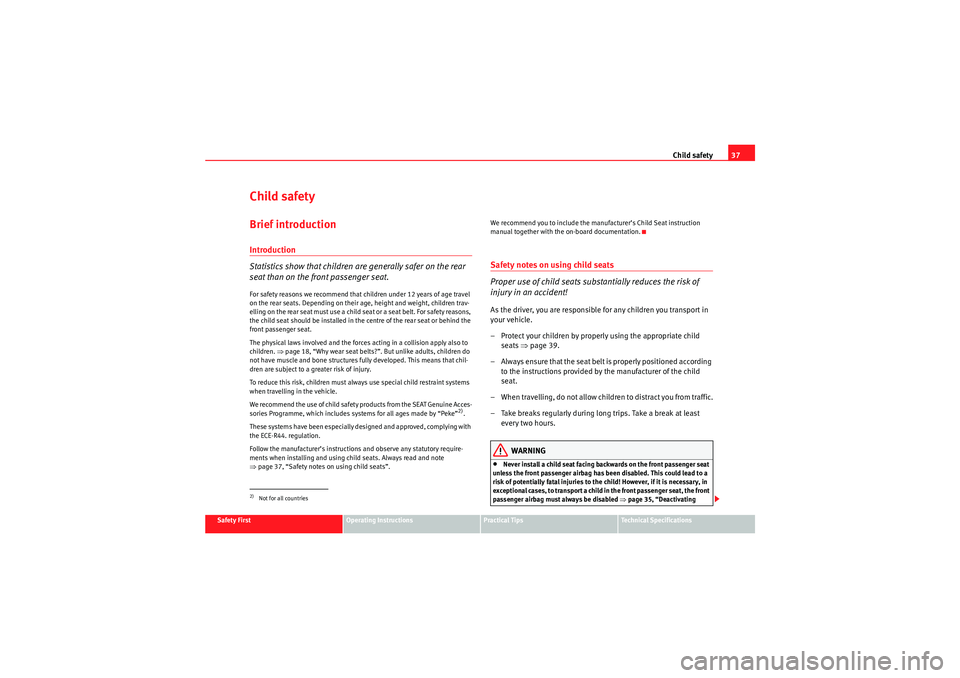
Child safety37
Safety First
Operating Instructions
Practical Tips
Technical Specifications
Child safetyBrief introductionIntroduction
Statistics show that children are generally safer on the rear
seat than on the front passenger seat.For safety reasons we recommend that children under 12 years of age travel
on the rear seats. Depending on their age, height and weight, children trav-
elling on the rear seat must use a child seat or a seat belt. For safety reasons,
the child seat should be installed in the centre of the rear seat or behind the
front passenger seat.
The physical laws involved and the forces acting in a collision apply also to
children. ⇒page 18, “Why wear seat belts?”. But unlike adults, children do
not have muscle and bone structures fully developed. This means that chil-
dren are subject to a greater risk of injury.
To reduce this risk, children must always use special child restraint systems
when travelling in the vehicle.
We re co m m en d t he use o f child saf et y p rod uc ts fr om t he SE AT Ge nu ine Acces -
sories Programme, which includes systems for all ages made by “Peke”
2).
These systems have been especially designed and approved, complying with
the ECE-R44. regulation.
Follow the manufacturer’s instructions and observe any statutory require-
ments when installing and using child seats. Always read and note
⇒ page 37, “Safety notes on using child seats”. We recommend you to include the manufacturer’s Child Seat instruction
manual together with the on-board documentation.
Safety notes on using child seats
Proper use of child seats substantially reduces the risk of
injury in an accident!As the driver, you are responsible for any children you transport in
your vehicle.
– Protect your children by properly using the appropriate child
seats ⇒page 39.
– Always ensure that the seat belt is properly positioned according
to the instructions provided by the manufacturer of the child
seat.
– When travelling, do not allow children to distract you from traffic.
– Take breaks regularly during long trips. Take a break at least
every two hours.
WARNING
•Never install a child seat facing backwards on the front passenger seat
unless the front passenger airbag has been disabled. This could lead to a
risk of potentially fatal injuries to the child! However, if it is necessary, in
exceptional cases, to transport a child in the front passenger seat, the front
passenger airbag must always be disabled ⇒page 35, “Deactivating
2)Not for all countries
Ibiza_EN.book Seite 37 Mittwoch, 1. September 2010 5:24 17
Page 41 of 266
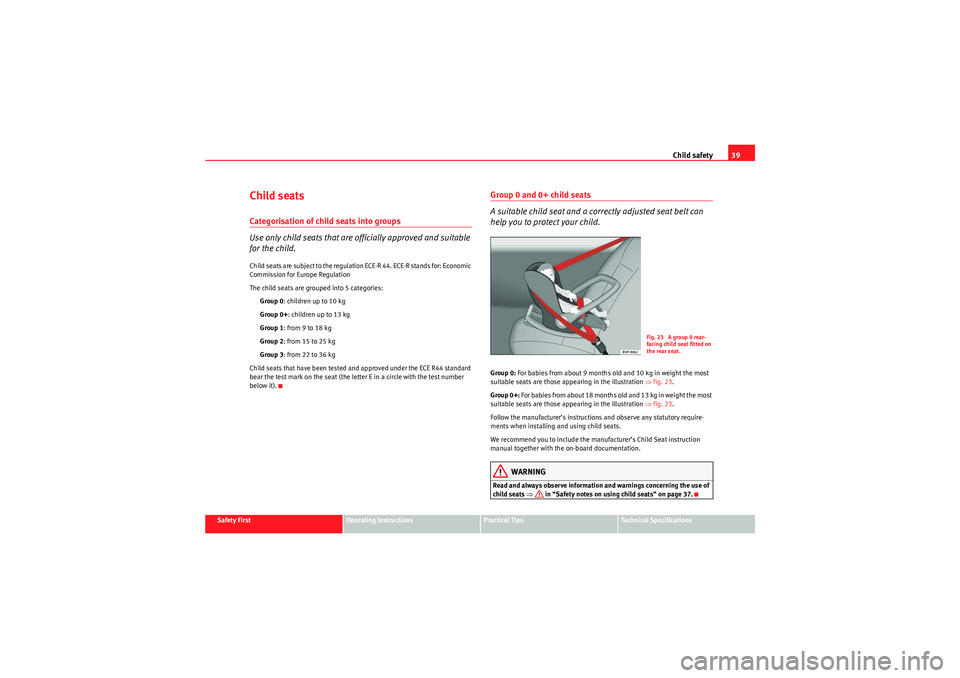
Child safety39
Safety First
Operating Instructions
Practical Tips
Technical Specifications
Child seatsCategorisation of child seats into groups
Use only child seats that are officially approved and suitable
for the child.Child seats are subject to the regulation ECE-R 44. ECE-R stands for: Economic
Commission for Europe Regulation
The child seats are grouped into 5 categories:
Group 0 : children up to 10 kg
Group 0+ : children up to 13 kg
Group 1 : from 9 to 18 kg
Group 2 : from 15 to 25 kg
Group 3 : from 22 to 36 kg
Child seats that have been tested and approved under the ECE R44 standard
bear the test mark on the seat (the letter E in a circle with the test number
below it).
Group 0 and 0+ child seats
A suitable child seat and a correctly adjusted seat belt can
help you to protect your child.Group 0: For babies from about 9 months old and 10 kg in weight the most
suitable seats are those appearing in the illustration ⇒fig. 23 .
Group 0+: For b ab ies f ro m ab o ut 18 m o nth s old a nd 1 3 kg in wei ght th e m ost
suitable seats are those appearing in the illustration ⇒fig. 23 .
Follow the manufacturer’s instructions and observe any statutory require-
ments when installing and using child seats.
We recommend you to include the manufacturer’s Child Seat instruction
manual together with the on-board documentation.
WARNING
Read and always observe information and warnings concerning the use of
child seats ⇒ in “Safety notes on using child seats” on page 37.
Fig. 23 A group 0 rear-
facing child seat fitted on
the rear seat.
Ibiza_EN.book Seite 39 Mittwoch, 1. September 2010 5:24 17
Page 43 of 266

Child safety41
Safety First
Operating Instructions
Practical Tips
Technical Specifications
WARNING
•The shoulder part of the seat belt must lie approximately on the centre
of the shoulder, never across the neck or the arm. The seat belt must lie
close to the upper part of the body. The lap belt part must lie across the
pelvis, not across the stomach, and always fit closely. Pull the belt tight if
necessary to take up any slack ⇒page 21, “Seat belts”.•Read and always observe information and warnings concerning the use
of child seats ⇒ in “Safety notes on using child seats” on page 37.
Ibiza_EN.book Seite 41 Mittwoch, 1. September 2010 5:24 17